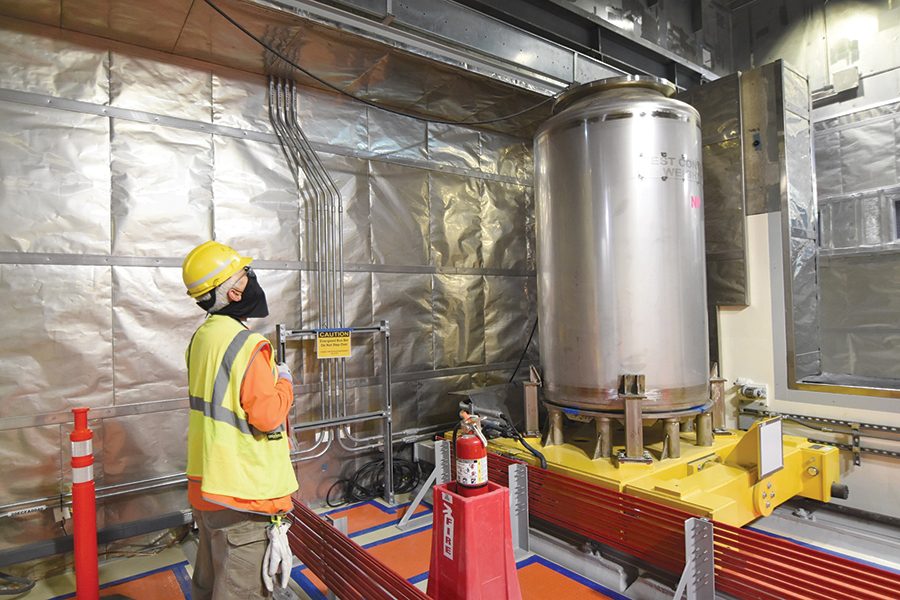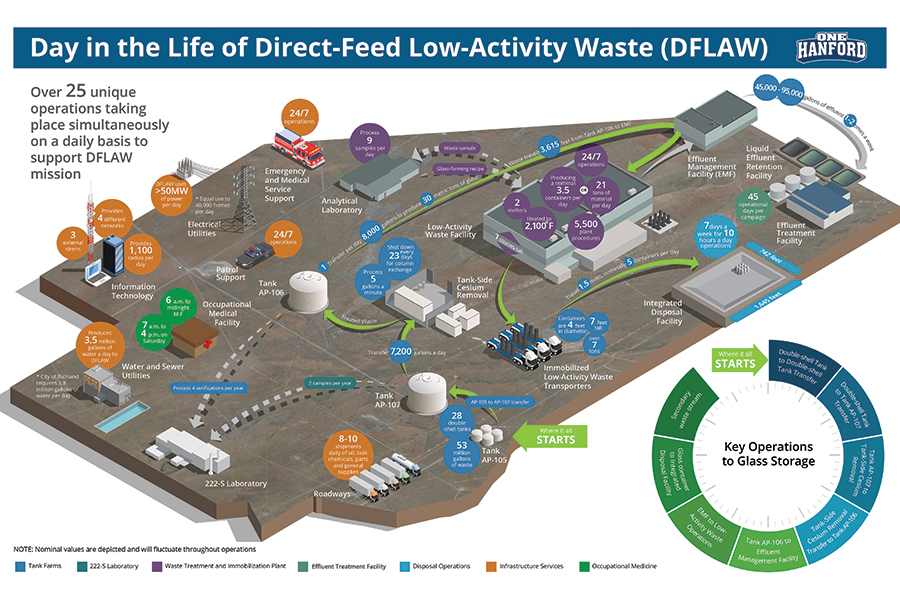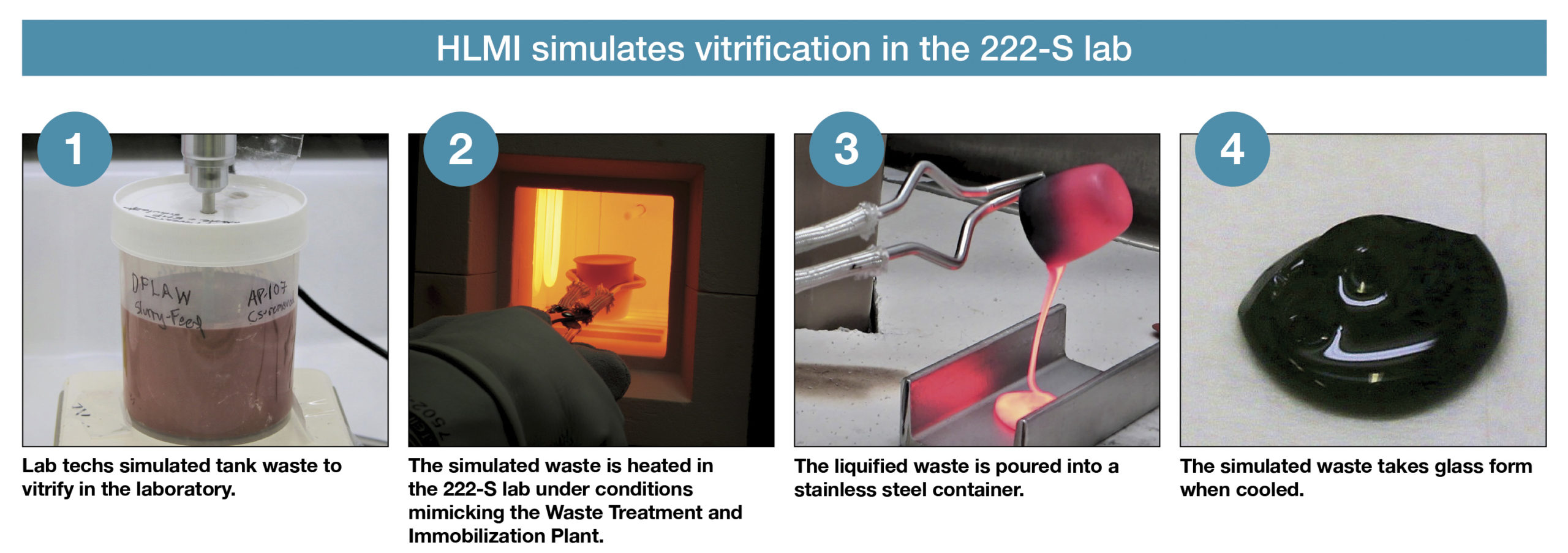
Home » 2022 highlights include vit plant startup, groundwater progress, reactor cocooning and more
2022 highlights include vit plant startup, groundwater progress, reactor cocooning and more

April 14, 2022
Everything about Hanford is huge.
- Its area: 580 square miles.
- Its waterfront: 40 miles of Columbia River.
- Its workforce: 10,000, including 300 federal employees.
- Its payroll: $500 million plus, or about a quarter of all local wages.
- Its budget: $2.6 billion, with $560 million awarded to subcontractors in 2021.
- Its history: Helping end World War II by fueling the U.S. nuclear arsenal.
And its biggest challenge: 18 distinct waste storage units that include 177 underground tanks (149 single-shell, 28 double-shell) containing approximately 56 million gallons of radioactive and chemical waste from the production of weapons-grade plutonium.
Of those, 60 tanks have collectively leaked up to a million gallons that in some areas have reached the groundwater.
In 2022, Hanford still continues to draw attention.
Geologists are fascinated by the millions of years of forces that have acted on it. Historians note its pivotal role in bringing about the end of World War II and its role in the Cold War.
Scientists and engineers embrace the daunting challenge of cleaning up nuclear and toxic wastes. Politicians battle for enough money to pay for it all.

A return to area-wide operations
Progress is incremental, but 2022 will see the site return to the kind of area-wide operations that haven’t been seen since plutonium production and processing ended. Instead of producing material for the nation’s weapons arsenal, multiple systems across the reservation will come online to carry out the task of stabilizing radioactive waste.
“The site is fundamentally transforming into full operations mode. That hasn’t been the case since the ’80s, when the site last operated in a national security mission,” said Brian Vance, manager of the U.S. Department of Energy offices in Richland. Vance recently updated the Tri-City Development Council on progress at the site.
Bechtel National Inc., DOE’s treatment plant contractor, completed construction of the $17 billion Waste Treatment and Immobilization Plant in 2021, with commissioning continuing into 2022. The first of two 300-ton melters will be heated up and tested this year, with formal vitrification expected to begin in 2023.
The second melter will be heated up once the lessons of the first have been assessed.
To kick off the vitrification process, tank waste must be treated for cesium and other solids. To that end, construction of the Tank-Side Cesium Removal System wrapped in 2021. It began operating in January and by early April had treated 200,000 gallons, which will eventually be sent to the vit plant to be stabilized in glass logs.

Infrastructure is key
To support it all entails infrastructure, an upgraded effluent treatment facility and integrated disposal facility for storage of waste canisters at the end.
Elsewhere on the site, more than 2 billion gallons of contaminated groundwater were treated in 2021, bringing the total to 28 billion gallons as Hanford works to address subsurface contamination.
Vance, in his remarks to TRIDEC, was particularly happy to report on a task that has dropped off the to-do list: The Plutonium Finishing Plant, or PFP.
“We no longer have to talk about the Plutonium Finishing Plant because it’s done,” he said with relish.
The decades-long effort to place eight plutonium production reactors into interim safe storage extends to the River Corridor’s 100 Area. K East Reactor is being covered with a weather-resistant structure with foundations poured. K West Reactor will be completed by the end of the decade.
The reactors
With that work, all but one of the reactors will be cocooned, waiting for their cores to decay to levels safe enough to demolish them in the future.
TB Reactor, the world’s first production reactor and the source of plutonium in the war-ending bomb dropped on Nagasaki, Japan, is preserved as part of the Manhattan Project National Park.
The park’s Hanford unit visitor center is closed and public tours have been postponed due to the pandemic. A reopening date has not yet been announced.
To better picture what the site looks like for those who have never visited, go to: bit.ly/HanfordTours.
Other top priorities
Transferring nearly 2,000 radioactive cesium capsules from underwater basins so they can be placed in safer dry systems is another top priority in 2022, as is preparing to remove highly contaminated soil under the 324 building, which is north of the Richland city boundary and only a few hundred yards from the Columbia River.
And finally, on March 15, President Joe Biden signed a $1.5 trillion appropriations bill that funds the federal government through the end of the fiscal year, which ends Sept. 30, 2022.
The budget includes $2.6 billion for Hanford and restored payments to local government that the president initially wanted to eliminate. With the 2022 budget finalized, negotiations for 2023 have started.
Hanford
KEYWORDS april 2022




